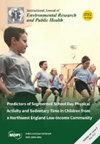The Effect of Manual Therapy on Psychological Factors and Quality of Life in Lumbar Disc Herniation Patients: A Single Blinded Randomized Clinical Trial
3区 综合性期刊
Q1 Medicine
International Journal of Environmental Research and Public Health
Pub Date : 2024-09-18
DOI:10.3390/ijerph21091234
引用次数: 0
Abstract
Background: This study aimed to investigate the effect of manual therapy on pain, kinesiophobia, pain catastrophizing, anxiety, depression, and quality of life in patients with lumbar disc herniation (LDH). Methods: The study included 32 LDH patients. Patients were divided into the Manual therapy group (MTG—age 39.81 ± 9.45 years) and the Exercise group (EG—age 38.31 ± 9.21 years) by sealed envelope randomization. Patients were evaluated pre-study, post-study, and after a 3-month period using the McGill–Melzack Pain Questionnaire (MMPQ), Hospital Anxiety and Depression Scale (HADS), Tampa Kinesiophobia Scale (TKS), Pain Catastrophizing Scale (PCS) and Nottingham Health Profile (NSP). The exercise group received a total of ten sessions of stabilization exercises and sham spinal mobilization in five weeks, two sessions per week. In addition to the stabilization exercises, mobilization applications including Anterior-Posterior Lumbar Spinal Mobilization, Lumbar Spinal Rotational Mobilization, and Joint Mobilization in Lumbar Flexion Position, were applied to the manual therapy group. Results: It was found that the HADS and TKS values decreased in the MTG group compared to the pre-treatment period (p < 0.05), while there was no difference between these values in the EG group (p > 0.05). There was a statistically significant difference in the MMPQ, PCS, and NHP values after treatment in both the MTG and EG groups (p < 0.05). Conclusions: It was found that manual therapy had positive effects on psychological factors such as pain, kinesiophobia, pain catastrophizing, anxiety, depression, and quality of life in patients with LDH. Trial registration: NCT05804357 (27 March 2023) (retrospectively registered).手法治疗对腰椎间盘突出症患者心理因素和生活质量的影响:单盲随机临床试验
研究背景本研究旨在探讨手法治疗对腰椎间盘突出症(LDH)患者的疼痛、运动恐惧、疼痛灾难化、焦虑、抑郁和生活质量的影响。研究方法研究包括 32 名腰椎间盘突出症患者。患者通过密封信封随机分为手法治疗组(MTG-年龄 39.81 ± 9.45 岁)和运动组(EG-年龄 38.31 ± 9.21 岁)。在研究前、研究后和 3 个月后,使用麦吉尔-梅尔扎克疼痛问卷(MMPQ)、医院焦虑抑郁量表(HADS)、坦帕运动恐惧症量表(TKS)、疼痛灾难化量表(PCS)和诺丁汉健康档案(NSP)对患者进行评估。运动组在五周内共接受了十次稳定运动和假性脊柱活动治疗,每周两次。除稳定训练外,手法治疗组还采用了包括腰椎前后移动、腰椎旋转移动和腰椎屈曲位关节移动在内的移动应用。结果显示结果发现,与治疗前相比,MTG 组的 HADS 和 TKS 值有所下降(P < 0.05),而 EG 组的这些值之间没有差异(P > 0.05)。治疗后,MTG 组和 EG 组的 MMPQ、PCS 和 NHP 值均有显著差异(P < 0.05)。结论研究发现,手法治疗对 LDH 患者的疼痛、运动恐惧、疼痛灾难化、焦虑、抑郁和生活质量等心理因素有积极影响。试验注册:NCT05804357(2023年3月27日)(回顾性注册)。
本文章由计算机程序翻译,如有差异,请以英文原文为准。
求助全文
约1分钟内获得全文
求助全文
来源期刊

International Journal of Environmental Research and Public Health
Medicine-Public Health, Environmental and Occupational Health
CiteScore
7.30
自引率
0.00%
发文量
14422
审稿时长
1 months
期刊介绍:
International Journal of Environmental Research and Public Health (IJERPH) (ISSN 1660-4601) is a peer-reviewed scientific journal that publishes original articles, critical reviews, research notes, and short communications in the interdisciplinary area of environmental health sciences and public health. It links several scientific disciplines including biology, biochemistry, biotechnology, cellular and molecular biology, chemistry, computer science, ecology, engineering, epidemiology, genetics, immunology, microbiology, oncology, pathology, pharmacology, and toxicology, in an integrated fashion, to address critical issues related to environmental quality and public health. Therefore, IJERPH focuses on the publication of scientific and technical information on the impacts of natural phenomena and anthropogenic factors on the quality of our environment, the interrelationships between environmental health and the quality of life, as well as the socio-cultural, political, economic, and legal considerations related to environmental stewardship and public health.
The 2018 IJERPH Outstanding Reviewer Award has been launched! This award acknowledge those who have generously dedicated their time to review manuscripts submitted to IJERPH. See full details at http://www.mdpi.com/journal/ijerph/awards.
 求助内容:
求助内容: 应助结果提醒方式:
应助结果提醒方式:


